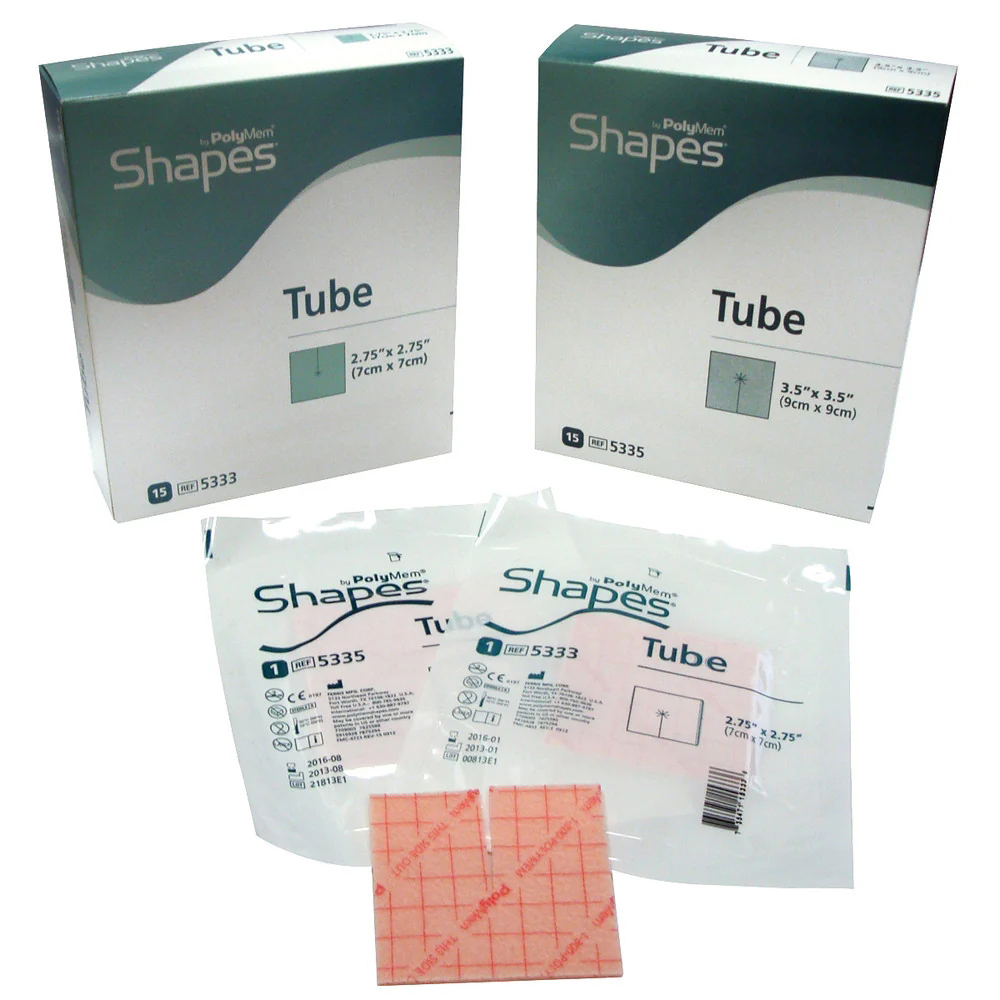PolyMem Shapes Tube Dressing is a specially engineered wound care solution designed to provide exceptional comfort, protection, and healing support around tube sites. Cut and shaped for optimal fit, this soft and flexible dressing helps manage common peri-tube complications—such as irritation, maceration, inflammation, hypergranulation, and odor—while providing continuous cleansing, moisturization, and high absorbency. Ideal for delicate skin, PolyMem Shapes Tube Dressing offers gentle, consistent care for a wide range of long- and short-term tube applications.
Features & Benefits
- Latex-free.
- Absorbs peri-tube secretions effectively.
- Helps promote rapid healing of damaged or compromised skin.
- Includes glycerin for soothing comfort, moisturization, and reduced odor.
- Supports autolytic debridement while protecting healthy tissue.
- Flexible, soft, non-fibrous foam designed specifically for tube sites.
- Non-adherent and gentle for extremely delicate skin.
- Allows pain-free dressing changes and minimizes patient discomfort.
- Fenestrated pad supports secure placement around tubes.
- Contains a mild cleansing agent activated by moisture or wound drainage.
- Helps loosen debris, reduce interfacial tension, assist debridement, and keep the wound bed clean.
- Reduces the need for manual cleansing, minimizing disruption to healing tissue.
- Polyurethane membrane wicks away up to ten times its weight in exudate.
- The superabsorbent pad binds excess fluid while keeping beneficial growth factors at the wound site.
- Semi-permeable backing supports ideal moisture vapor transmission and gas exchange.
- Can effectively replace polyurethane foams, silicone foams, hydrogels (when moistened), hydrocolloids, transparent films, gauze, and traditional dressings.
- Helps reduce odor, manage moisture, prevent rashes, and streamline dressing change time.
How to Apply
Initial Application
- Prepare the wound according to clinician protocol.
- Select a PolyMem Shapes Tube Dressing sized so the membrane extends about ¼"–2" (0.6–5 cm) beyond the wound.
- For dry wounds, lightly moisten with sterile saline or water before applying.
- Apply with the printed side or film side facing outward.
- An increase in wound fluid within the first days is normal and indicates dressing activity.
- Keep the dressing dry when bathing; replace if wet.
- Do not use topical treatments under the dressing.
Dressing Changes
- Change the dressing before visible fluid reaches the wound margin.
- Replace immediately if fluid reaches the edge of the membrane pad.
- For mildly exudating wounds on otherwise healthy patients, dressings may remain in place up to seven days.
- More frequent changes may be needed for patients with infection, diabetes, or compromised immunity.
- To remove, gently pull toward the center; the pad will not adhere to the wound bed.
- Do not manually cleanse the wound unless infected—PolyMem contains its own cleanser.
- Clean only the surrounding intact skin if needed.
- Apply a new dressing.
Indications for Use
PolyMem Shapes Tube Dressing is designed for care around:
- PEG and gastrostomy sites
- Suprapubic catheter sites
- Tracheostomies and laryngectomies
- Other long-term and short-term tube sites
Warnings
- Always follow clinician instructions for wound care.
- Change dressings promptly when saturation reaches pad edges.
- Keep dressing dry; replace if wet.
- Do not apply additional topical agents under the dressing.
Storage
- Store in a clean, dry environment.
- Keep sealed until use to maintain sterility and dressing performance.
- Protect from moisture, contaminants, and damage.
Use & Application
PolyMem Shapes Tube Dressing provides advanced peri-tube skin management through continuous cleansing, moisture balancing, and high absorbency. Designed specifically to fit and protect tube sites, it reduces inflammation, maceration, hypergranulation, and odor while ensuring gentle, pain-free dressing changes. Its multifunctional foam formulation supports faster healing and greater patient comfort, making it a dependable choice for clinical and home care settings.
